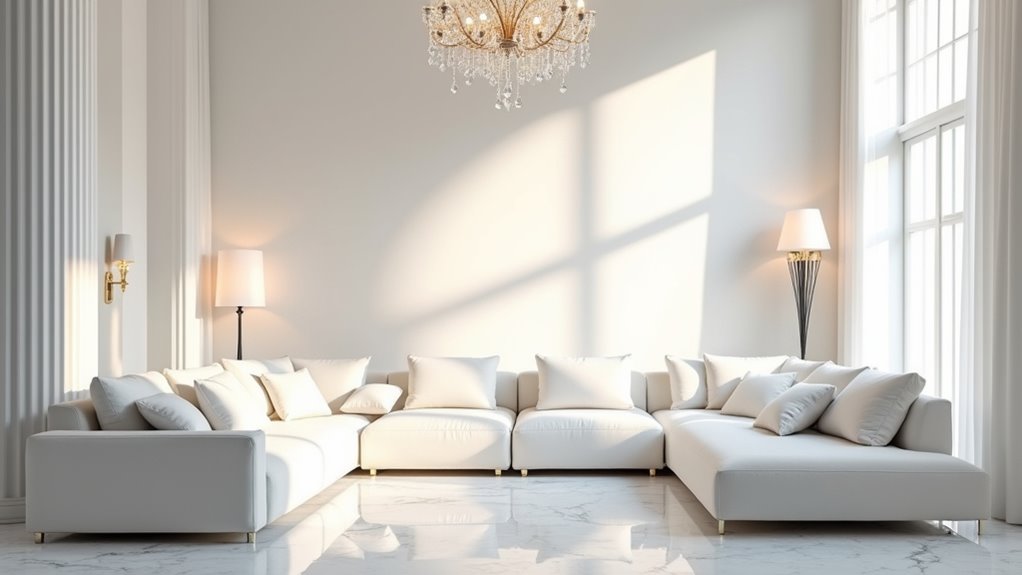Selecting the ideal white living room light involves strategic choices. Layer ambient, task, and accent lighting for depth. Opt for warm white bulbs (2700K–3000K) to create coziness. Match fixtures to the room’s style, like sleek metals for modern decor. Balance brightness with dimmers to avoid harshness. Manage reflectivity using matte finishes. Highlight textures with angled lights. Add warmth via brass fixtures. Choose high-CRI bulbs for true colors. Explore further for deeper insights.
Key Takeaways
- Layer ambient, task, and accent lighting for balanced illumination in a white living room.
- Choose warm white bulbs (2700K–3000K) for a cozy, inviting atmosphere.
- Use dimmer switches to adjust brightness and control mood effectively.
- Select fixtures matching your decor style, like sleek metals for modern aesthetics.
- Opt for high CRI bulbs (90+) to ensure true color representation.
Understand the Power of Light Layering
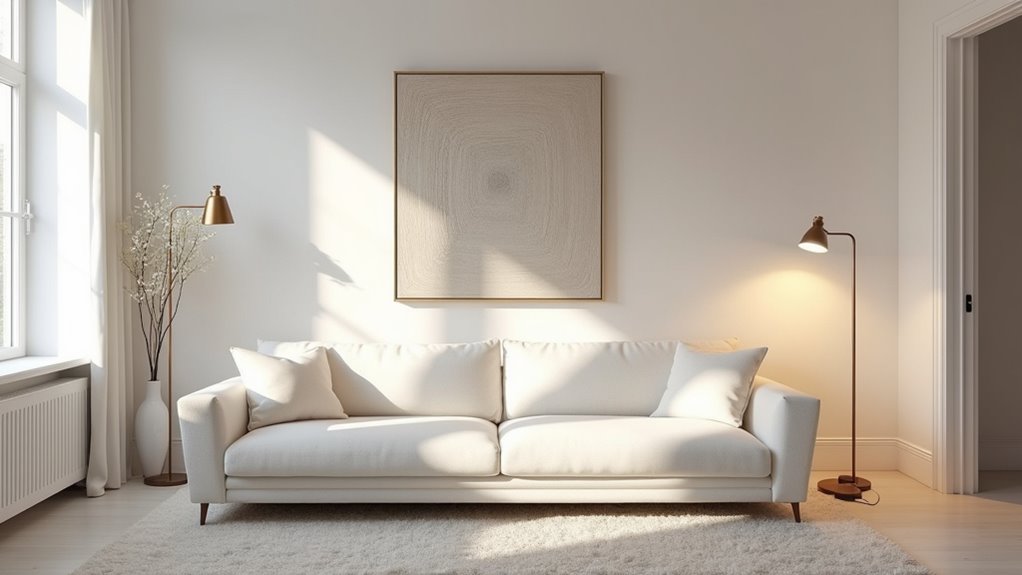
Three essential types of lighting—ambient, task, and accent—form the cornerstone of effective light layering in a white living room. Ambient lighting provides general illumination, reflecting off white surfaces to create a sense of spaciousness while ensuring safe navigation.
Task lighting offers focused brightness for activities like reading, preventing eyestrain with targeted fixtures such as floor lamps.
Accent lighting, meanwhile, introduces drama by highlighting artwork or architectural features, adding depth and visual interest. To achieve a cohesive look, consider using bulbs with a consistent color temperature, ideally around 2,700K, to maintain a warm and inviting cozy home feel.
Implementing layering techniques requires a strategic approach to lighting hierarchy. Start with ambient as the foundational layer, then integrate task lighting in functional zones, and finally, position accent lights to emphasize focal points. Layered lighting also enhances the room’s depth and dimension, transforming a dull space into an engaging environment enhances depth and dimension.
Mastering light layering begins with ambient as the base, followed by task lighting in key areas, and accent lights for striking focal points.
This structured method ensures balance and adaptability. Utilizing dimmer switches for each layer allows precise control over mood and atmosphere, transforming the space from flat to dynamic, while enhancing both aesthetic appeal and practical functionality in a white living room.
Choose the Right Color Temperature
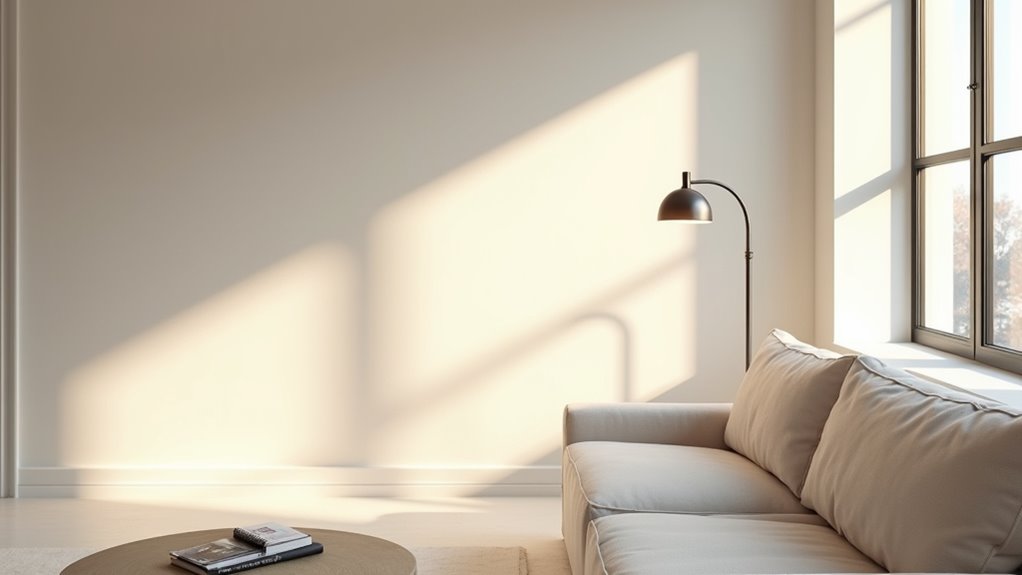
Selecting the ideal color temperature for a white living room is crucial to achieving both functional and aesthetic harmony. Measured in Kelvin (K), color temperature ranges from warm (2700K-3000K) to cool (above 4500K).
Warm white light fosters a cozy, inviting atmosphere, enhancing warm tones in decor and complementing white walls by counteracting unwanted hues. It also helps ensure color consistency across the space.
For versatility, neutral white (3500K-4500K) offers balanced illumination. It is ideal for multifunctional living rooms, delivering clarity without harshness.
Cool white (5000K+) provides a crisp, energizing effect but may feel less cozy. This range is better suited for task-oriented areas.
When choosing, consider bulb longevity alongside aesthetic impact. Higher quality bulbs maintain color consistency over time, ensuring lasting visual appeal.
Select Fixtures That Match Your Style
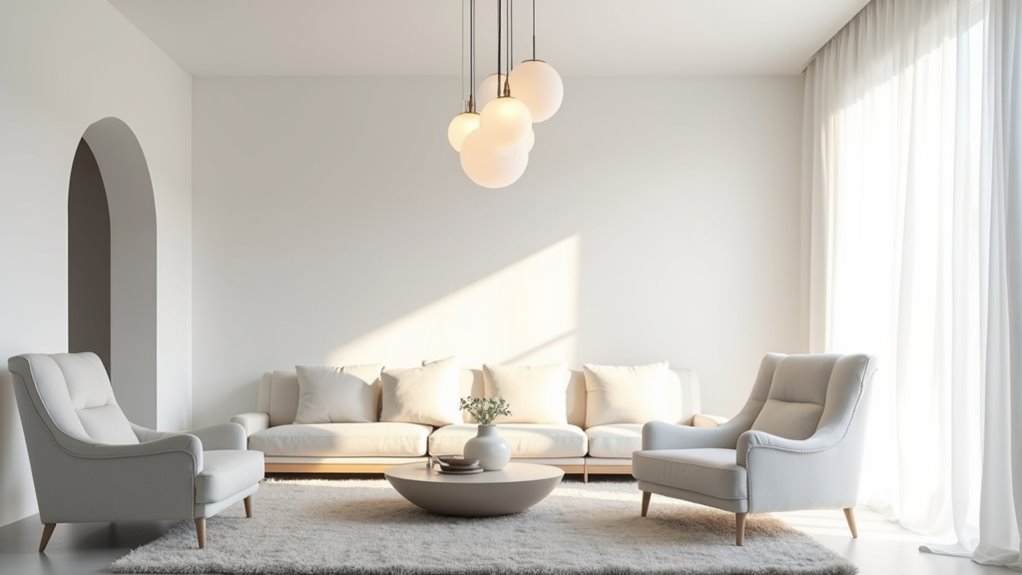
Beyond the impact of color temperature, the choice of lighting fixtures plays a significant role in defining the ambiance and character of a white living room. The selection of Fixture Materials and Fixture Shapes must align with the room’s aesthetic to create a cohesive look.
For a modern style, sleek metal or glass fixtures with geometric shapes, like drum pendants, enhance simplicity. Minimalist designs favor subtle materials in neutral tones and linear shapes, such as white track lights blending into ceilings.
Industrial styles utilize dark metals in sturdy, authentic shapes, like wire cage pendants, for a rugged contrast.
Bohemian aesthetics embrace natural Fixture Materials like rattan with curved Fixture Shapes, offering a relaxed vibe.
Traditional decor calls for elegant brass or crystal materials in ornate shapes, such as classic chandeliers, to evoke timeless warmth.
Matching fixtures to style ensures a harmonious and visually appealing space.
Balance Brightness for Comfort

Achieving optimal brightness in a white living room begins with measuring the room’s lumens to ensure illumination falls within the recommended 1,500 to 3,000 range, tailored to the space’s size and purpose.
Adjusting light levels to suit specific activities or moods is essential, preventing an overly harsh or sterile ambiance that can disrupt comfort.
Installing dimmer switches offers a practical solution, providing precise control over intensity for both functional and aesthetic balance.
Measure Room Lumens
Countless factors influence the perfect lighting for a living room, but understanding lumens is a critical starting point for achieving balanced brightness. Lumens measure the total visible light emitted by a source, with higher ratings indicating brighter output.
To calculate the required lumens, one must first determine the room’s square footage by multiplying length by width. For a 120-square-foot space, aiming for 10-20 foot-candles—equivalent to one lumen per square foot—yields a target of 1,200-2,400 lumens.
This technical approach ensures comfort by avoiding over- or under-lighting. Factors like dark walls or high ceilings may necessitate additional lumens for aesthetic harmony.
Layering multiple light sources can meet this target, creating a practical and visually pleasing environment without harshness or dimness.
Adjust Light Levels
Selecting the right light levels in a white living room requires a thoughtful approach to balance brightness and ensure comfort. Layering techniques are essential, combining ambient, task, and accent lighting from multiple sources at varying heights.
Start with ambient lighting as the foundation. Then, strategically place lamps in corners to eliminate shadows and enhance warmth.
Equally critical is maintaining color consistency across light sources. Opt for warm white bulbs (2700K-3000K) to create a cozy ambiance, avoiding cooler tones that can feel harsh in reflective white spaces.
Supplement natural light with artificial sources during dim hours or in darker areas, using diffusers to prevent glare.
This balanced approach ensures a visually appealing and comfortable environment tailored to the room’s unique aesthetic.
Use Dimmer Switches
Building on the concept of balancing light levels in a white living room, incorporating dimmer switches offers a refined solution for controlling brightness with precision. These devices allow users to fine-tune light intensity, reducing glare and creating a visually comfortable environment for tasks or relaxation.
With smart home integration, modern dimmers enable remote or voice control, enhancing versatility for mood setting or activity-specific lighting.
Practically, dimmer switches provide significant energy saving benefits, cutting electricity costs by lowering light output and extending bulb lifespan through reduced heat and wear.
This eco-friendly approach aligns with sustainable living while maintaining aesthetic appeal. By seamlessly adjusting brightness, dimmer switches transform a white living room into a dynamic, functional, and inviting space for any occasion.
Incorporate Dimmer Controls for Flexibility
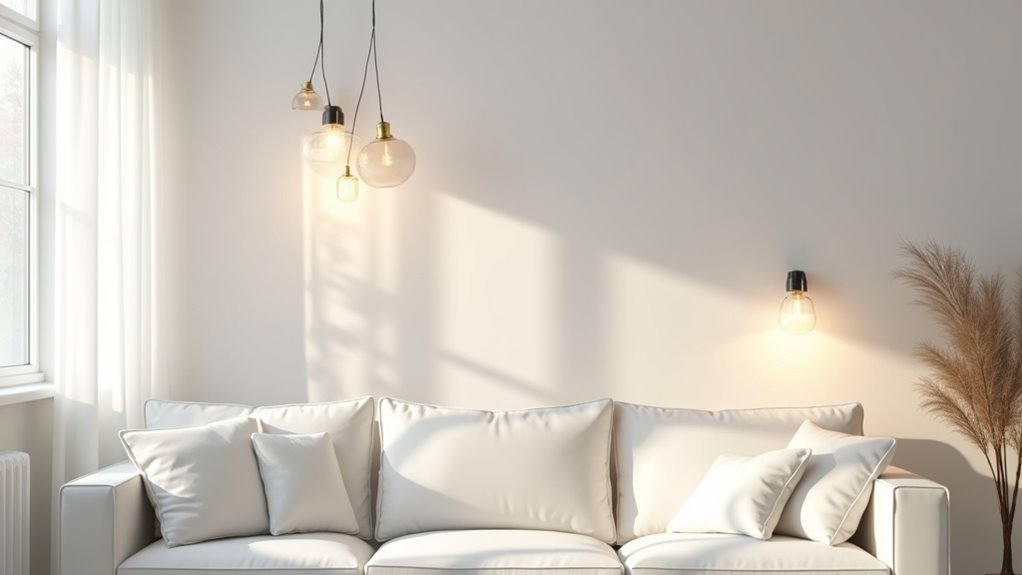
While designing a white living room, integrating dimmer controls offers unparalleled flexibility in lighting management. These devices enable precise adjustment of light intensity, facilitating mood customization for various activities or occasions.
Incorporating dimmer controls in a white living room provides exceptional flexibility, allowing precise light adjustments to match any mood or activity effortlessly.
Whether creating a cozy ambiance for movie nights or vibrant illumination for gatherings, dimmers allow seamless transitions between bright task lighting and soft relaxation glow, enhancing aesthetic appeal.
From a technical perspective, dimmers contribute to energy efficiency, reducing electricity consumption by up to 20% when dimmed by 25%. They also extend bulb lifespan, especially for LEDs, by minimizing wear and operating at cooler temperatures.
Smart integration with mobile apps or voice assistants like Alexa adds practicality, enabling remote control and automated scheduling for optimal comfort.
Additionally, dimmers reduce glare and eye strain, promoting well-being with tailored lighting levels.
This combination of functionality and style makes dimmer controls an essential feature for any white living room.
Consider Room Size and Ceiling Height
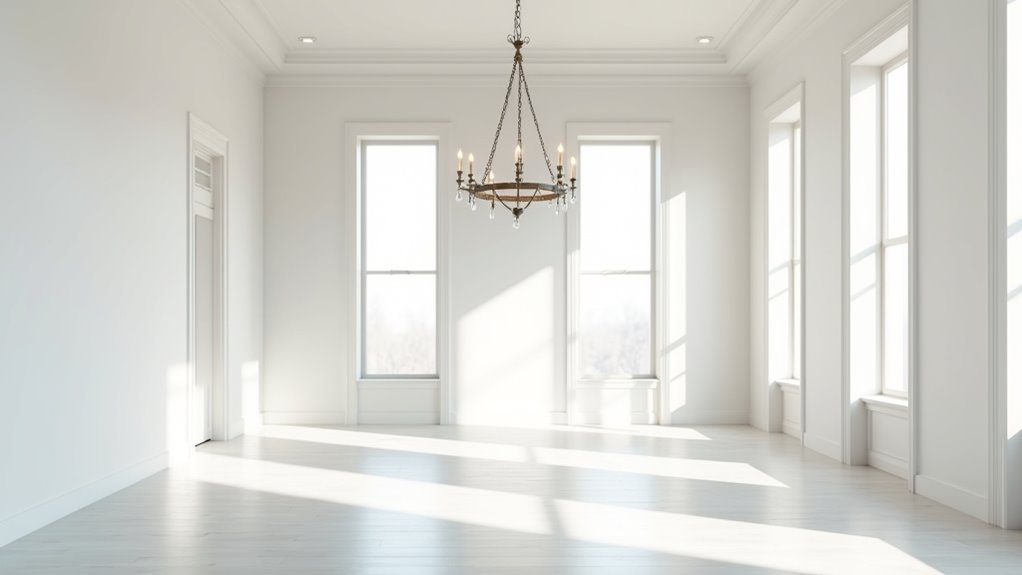
When selecting the ideal white living room light, one must first assess the room’s dimensions to ensure the fixture’s scale aligns with the space for both functionality and visual harmony.
Evaluating the ceiling height is equally critical, as it influences whether dramatic chandeliers or subtle flush mounts will best suit the environment and maintain clearance.
This dual consideration of size and height sets the foundation for a balanced and effective lighting design.
Assessing Room Dimensions
Determining the right lighting for a white living room begins with a careful assessment of room dimensions, as both size and ceiling height play critical roles in fixture selection. Larger spaces can handle grand chandeliers, while smaller rooms benefit from flush mounts to avoid visual clutter.
Light distribution varies with layout—long rooms need mixed fixtures like sconces, while square rooms suit central pendants.
A practical formula for fixture diameter is to add room length and width in feet, converting the sum to inches.
Wall color and ceiling color influence perceived brightness, so consider these when scaling fixtures. For low ceilings under 8 feet, opt for recessed lighting to preserve headroom. High ceilings over 10 feet allow dramatic, oversized pieces for aesthetic balance.
Evaluating Ceiling Impact
A critical aspect of selecting the ideal lighting for a white living room lies in evaluating the ceiling’s impact, as both height and room size dictate fixture choice and light distribution. Ceiling height influences whether flush mounts suit low spaces or chandeliers enhance high ones.
Room size demands proportional fixtures for balanced aesthetics. Ceiling color also affects perception—light shades reflect illumination, amplifying brightness, while dark tones absorb light, creating coziness.
Consider these practical insights for optimal lighting:
- Assess fixture hanging height—maintain 7 feet clearance, adjusting 2-3 inches per foot above 8 feet.
- Use uplighting to accentuate height.
- Ensure even light distribution in large rooms.
- Match fixture size to room dimensions for visual harmony.
Manage Reflectivity in White Spaces
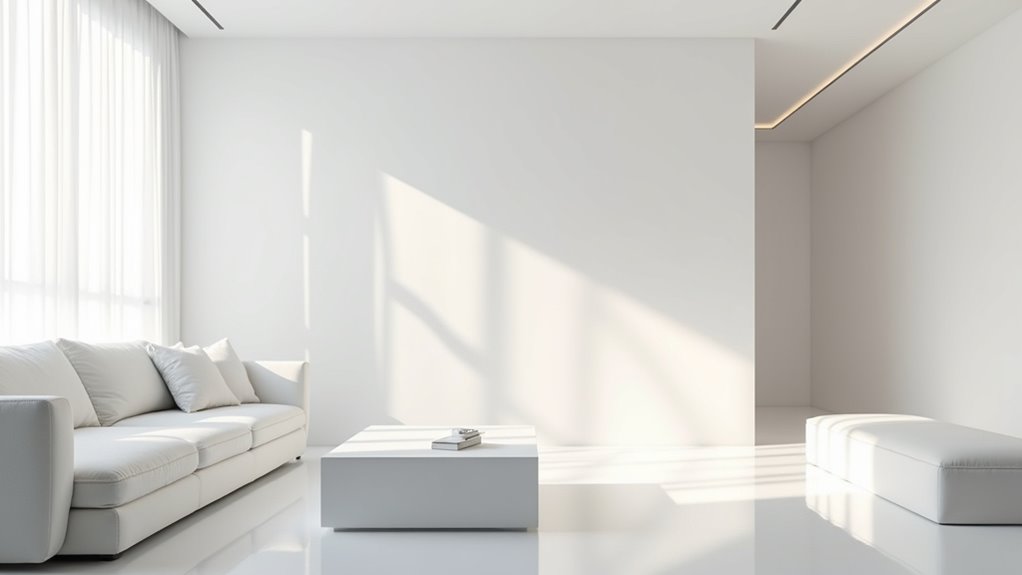
How can one mitigate the intense reflectivity often found in white living spaces? A strategic approach involves integrating matte surfaces and textured finishes to diffuse light effectively. Matte finishes on walls and ceilings scatter light, minimizing harsh glare. Meanwhile, textured materials like linen or wool in upholstery absorb illumination, softening the ambiance.
Opting for low-sheen paints or textured glossy surfaces further reduces reflections by dispersing light in varied directions. Beyond surface treatments, incorporating light-absorbing elements is crucial. Dark carpets or thick curtains can diminish floor and window reflections.
Strategic decor, such as artwork or greenery, breaks up expansive white areas, reducing starkness. Adjustable blinds and sheer curtains also help control natural light, preventing excessive glare. By thoughtfully combining these elements, one can achieve a balanced aesthetic, ensuring a white living room remains visually comfortable and inviting without the overpowering effects of reflectivity.
Add Warmth With Strategic Lighting
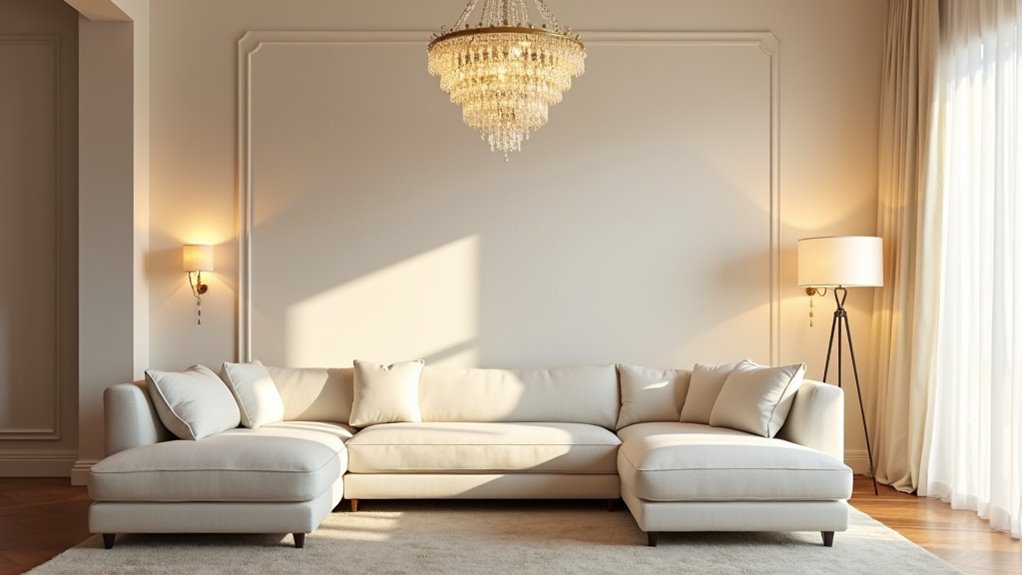
Several key strategies can transform a white living room into a warm, inviting space through thoughtful lighting choices. By focusing on layered illumination, one can combine ambient, task, and accent lighting to create depth and coziness.
Selecting bulbs in the 2700K-3000K range ensures a golden glow, while dimmer switches allow adjustable intensity for different moods. Fixture preferences also play a critical role, with soft-diffusing materials like fabric or frosted glass enhancing warmth.
To achieve a balanced aesthetic, consider these practical tips:
- Position floor lamps in darker corners to eliminate cold spots.
- Incorporate table lamps on side tables for intimate, warm pools of light.
- Install wall sconces for a gentle perimeter glow that softens stark walls.
- Use warm metal fixtures like brass or copper to complement the inviting ambiance.
Strategic placement and careful selection ensure a harmonious, welcoming environment in a white living room.
Highlight Textures and Decor Elements
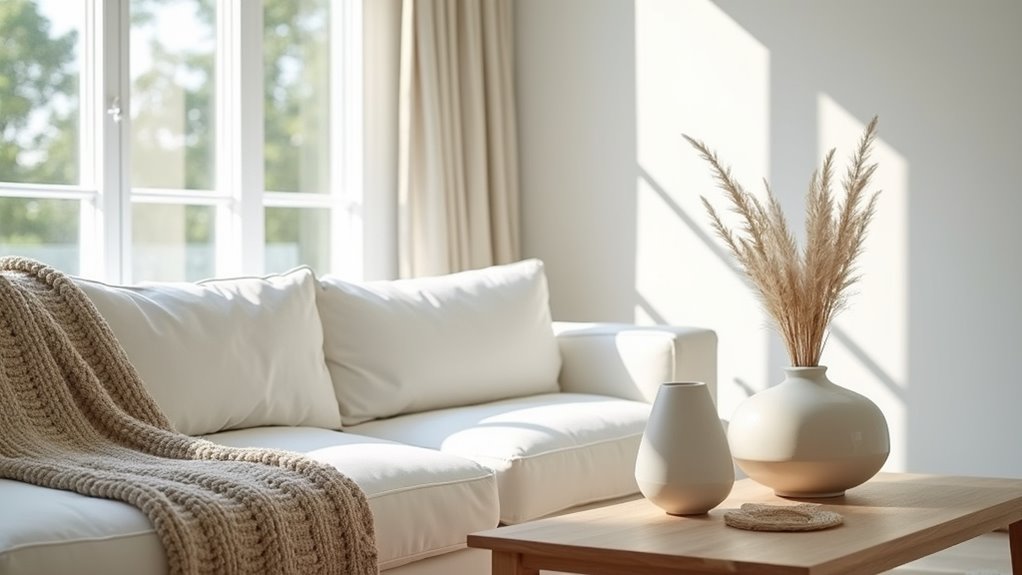
When selecting lighting for a white living room, one can emphasize fabric textures by using angled or grazing light to accentuate the depth of materials like curtains or upholstery.
Strategic accent lighting, such as spotlights or picture lights, proves effective in showcasing wall art, drawing the eye to intricate details and colors.
Additionally, highlighting decor accents with adjustable track lighting or wall sconces can create focal points, enhancing the room’s aesthetic appeal and visual balance.
Emphasize Fabric Textures
Creating a visually engaging white living room requires a thoughtful approach to emphasizing fabric textures and decor elements through strategic lighting. By layering ambient, task, and accent lighting, one can highlight fabric weaves and create texture contrast, adding depth to the space.
Strategic placement, such as grazing light across surfaces, enhances shadows and reveals material intricacies. To achieve this effect, consider these practical tips:
- Layer Lighting: Combine ambient and accent lighting to define fabric weaves.
- Position Strategically: Use directional lighting for texture contrast on upholstery.
- Select Warm Tones: Opt for 2700K-3000K bulbs to enrich fabric depth.
- Adjust Intensity: Install dimmers to control how textures appear.
Such techniques ensure a dynamic, visually rich white living room environment.
Showcase Wall Art
Illuminating wall art in a white living room demands a meticulous balance of technical precision and aesthetic finesse. LED illumination stands out as the optimal choice, preserving artwork by emitting no harmful UV or infrared light, especially when paired with UV filtering glass near windows to shield against natural light damage. Strategically angled lighting at 25-30 degrees enhances texture, creating subtle shadows that reveal brushstrokes and depth.
Consider the emotional impact of lighting choices:
| Lighting Effect | Emotional Resonance |
|---|---|
| Warm LED Glow | Cozy, nostalgic warmth |
| Cool LED Tone | Modern, crisp clarity |
| Grazing Shadows | Dramatic, mysterious allure |
| Even Wall Wash | Calm, harmonious balance |
| Focused Spotlight | Intense, captivating focus |
Such techniques ensure art captivates with practical elegance.
Highlight Decor Accents
Accent lighting serves as a pivotal tool for enhancing the visual appeal of a white living room by drawing attention to decor accents and textures. Strategically placed lights, such as vintage fixtures, can transform a space by highlighting statement pieces or botanical accents, adding depth and drama.
Techniques like wall washing or grazing emphasize textured surfaces, while uplighting under plants creates a lively ambiance.
To elevate the aesthetic, consider these practical accent lighting ideas:
- Track Lights: Repositionable to focus on multiple decor items.
- LED Strips: Add soft glows under shelves for subtle highlights.
- Wall Sconces: Frame decor while enhancing wall textures.
- Recessed Downlights: Direct light to showcase sculptures or heirlooms.
Such layering ensures a balanced, visually striking environment.
Opt for High-Quality Bulbs With Strong Color Rendering
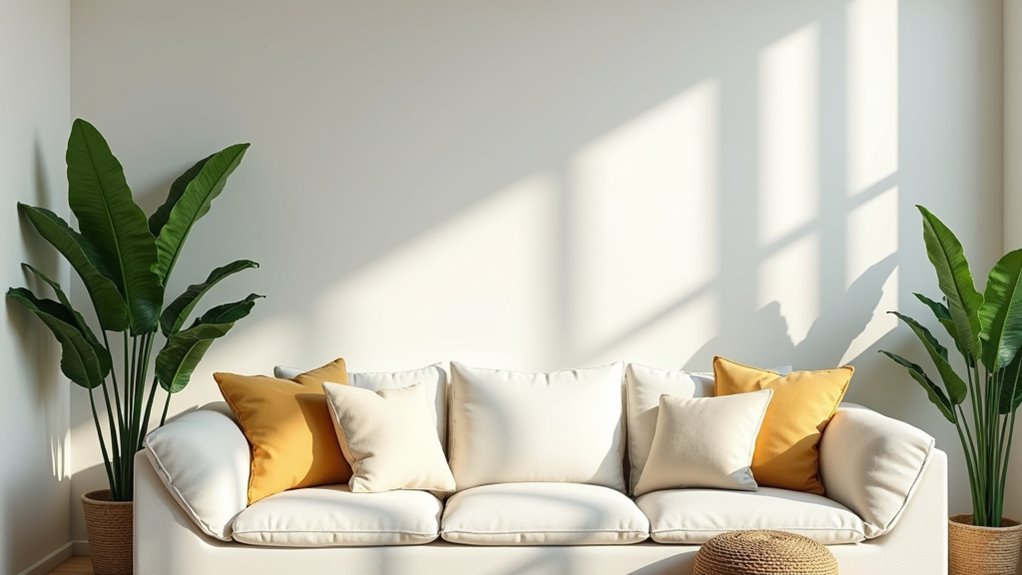
Selecting the right lighting for a white living room begins with prioritizing high-quality bulbs that offer strong color rendering. The CRI importance cannot be overstated, as it measures a bulb’s ability to reveal true colors on a scale of 0 to 100. A CRI of 90 or above is recommended to ensure vibrant, accurate hues, especially in white spaces where subtle tones matter.
The light spectrum also plays a critical role; bulbs with a continuous spectrum, like incandescent options, often achieve higher CRI, enhancing visual fidelity. Beyond CRI, high-quality bulbs elevate aesthetics by rendering decor and furniture colors as intended, creating a natural, inviting atmosphere.
Modern LEDs with CRI values of 90+ balance energy efficiency and excellent color clarity, while an R9 value for deep reds ensures lifelike skin tones. Such precision in lighting transforms a white living room into a visually comfortable, functional space for both ambiance and tasks.
